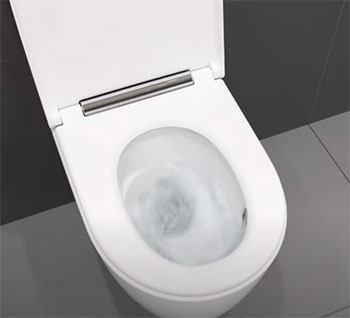In this article, we’ll look at the concerns with a Geberit toilet that keeps overflowing. Right now we’ll assist you in troubleshooting the issue so you can get back to work.
Toilets are one of the most often used equipment in our homes. They usually endure a long time and don’t cause too much trouble. But there can always be a problem.
When you have an overflowing toilet, it may be a tremendous mess!
Reasons Why Geberit Toilet Is Overflowing

Of course, it’s concerning when the Geberit toilet won’t stop running. A running toilet is not only irritating, but it can also increase your water bill as well. A toilet that runs intermittently or never stops is a waste of water in both cases.
You can locate the problematic element or hire a plumber to assist with the repair with a little detective work. Let’s discuss why the problem occurs:
- Problems with the Toilet Flapper
A toilet flapper’s job is to keep the flushing toilet from overflowing.
When you flush your toilet, a chain pulls up the flapper, allowing water to flow into the bowl. The flapper returns to its original position to re-seal the tank once enough water has been discharged.
Even after the flush cycle is over, if the flapper has rotted or cracked slightly, water will continue to flow out of the tank.
Drain the toilet and turn off the water supply to see if a malfunctioning flapper is causing the toilet to run occasionally.
After that, carefully remove the lid from your toilet tank and have a look inside. Examine the length of the chain to see if it’s too long or too short, as this could explain why the flapper hasn’t returned to its previous position.
Simply adjust the chain to the proper length if this is the case.
A build-up of dirt around the flapper may also contribute to a toilet that takes a long time to drain.
Before reinstalling the toilet flapper, clean it. If you see that the flapper is broken or cracked, you’ll need to have it replaced.
- GEBERIT Toilet Float Problems
The efficacy of your toilet is harmed by malfunctioning or incorrectly fitted float. The float may become entangled with the chain, obstructing its operation.
The float could be the source of the problem. Shake it and listen for water moving within to confirm this. If you hear water sloshing, the float is most likely clogged and has to be changed by a professional.
- Failure in The Fill Valve
A defective fill valve is frequently the source of a Geberit toilet that never stops running. Its replacement is the only option.
Turn off the water supply to do so. and completely drain your tank. The fill valve is secured to the toilet with a lock nut.
Remove the lock nut by rotating it anti-clockwise using an adjustable wrench. You can now reach the fill valve assembly and take it out of the tank once this is completed.
Bring the fill valve to a nearby hardware store to be replaced. When you’ve finished installing the new fill valve, tighten the nut clockwise to secure the water supply line.
To test, turn on the water supply once more. Your new fill valve. Allow the tank to fill with water, then check the level and adjust the float height if necessary.
How To Fix Overflowing Geberit Toilet?

Getting rid of the symptom is the key. This may also apply to other similar pieces, such as a toilet flush with two distinct buttons for flushing with a smaller or bigger amount of water.
Symptoms include: A Geberit toilet flush with different buttons for flushing with a modest or large volume of water is installed in your bathroom.
The tiny amount of water button eventually stops operating, whereas the large amount of water button continues to function.
It’s possible that the “small” button will work at first and then gets down. It may also become “stuck” on occasion, resulting in an unstoppable flush. The reason for this: One or both of the bell’s little latches have cracked.
We’ll use some very simple 3D-printed (or homemade) pieces to replace them. There’s no need to replace the whole bell.
- Remove the Cover from the Outside
Gently push upwards from underneath to remove the outer cover, then tilt the upper edge away from the toilet. Your cover’s make and model, as well as the mechanism for fixing it, may change. Try gently pressing and prying from the sides.
- Take away the outer frame.
Pull the blue fixation latches out of the way (one up, one down). Pull out the white plastic bolts by turning them inwards.
- Remove lid and mount bracket
Remove the white lid then press the latch to remove the mount bracket.
- Remove the Bell
If you haven’t already, turn off the water supply. Inside the tank, there is a handy valve (top left, blue) for this function in my case. Take the bell out of the tank. It’s held in place on the backside by a gray holder, which you’ll have to remove first.
With the limited room you have, the main challenge will be getting it out of the access hole. You’ll eventually succeed if you try different approaches. (After all, it got in some way, so it can also come out.)
- Find the Error
The “big” button raises the center cylinder, while the “small” button raises an assembly that is attached around it. The problem is that this outer assembly is also required to lift the inner cylinder, albeit only slightly.
The inner cylinder has a tiny rim. The inner cylinder is expected to be elevated at this point. Take note of the little latch that lifts the object. No? That’s because it’s no longer there.
On the other side, a second latch is supposed to be present. It’s most likely broken.
After finding out the problem now you can fix it if any parts of your Geberit toilet flush you can replace that part. Watch this video to fix your Geberit toilet.
Setting the Water Level Properly
This is on how to solve a dual flush toilet that is running due to too much water in the tank:
- Turn off the toilet’s water supply and flush the toilet.
- Remove the toilet tank’s lid and put it away.
- A long plastic screw can be found next to the toilet float. This screw is used to modify the float cup’s height and, as a result, the water level in the tank.
- Turn this screw counterclockwise with your hand or a screwdriver.
- Turn on the toilet’s water supply and observe the new water level. It should be about an inch and a half below the overflow tube.
- Flush the toilet soo see if it helps. Check whether the water level returns to the desired level.
Replace the toilet tank lid. Just the screw until the desired height is achieved.
Closing Remarks
Though it’s not always rainbow and butterfly and we understand sometimes things get complicated and gets difficult to find a proper solution.
Though Geberit is a famous brand sometimes it is very common that you will find problems with it and many times we have seen people complaining that Geberit toilet keeps overflowing.
We hope our detailed articles have helped you to give a direction for your problem.

